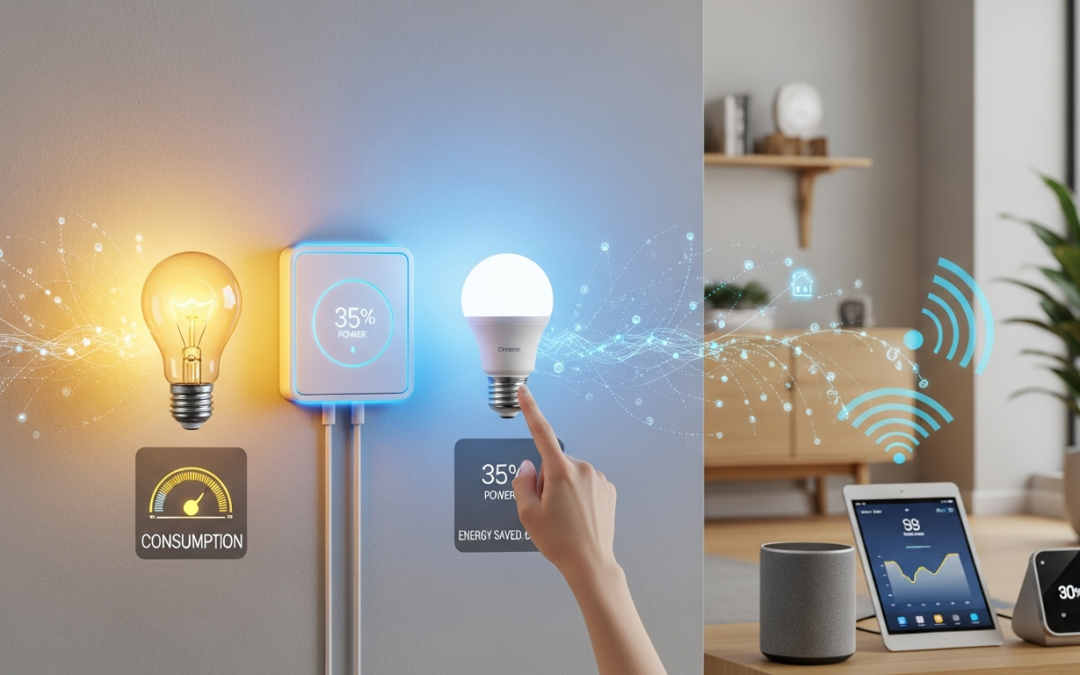The Current State of Lighting Controls: More Than an On/Off Switch
When homeowners consider energy conservation, they often concentrate on substituting outdated incandescent bulbs with new, energy-efficient LEDs. This represents a commendable initial measure. Nevertheless, the real advancement in electrical efficiency and fixture durability resides in the controls—the dimmers, sensors, and smart switches that we use on a daily basis. A mere flip or twist of a contemporary switch activates intricate electrical components engineered to regulate power flow with precision, leading to substantial savings and an enhanced lighting experience. As skilled electricians, we perceive these devices not merely as decorative controls, but as essential elements of energy management technology.
The Technical Evolution of Dimming: From Heat to Hacking the Current
The evolution of the dimmer is a perfect illustration of how electrical efficiency has advanced:
1. The Wasteful Past: The Rheostat
The earliest residential dimmers were simple devices called rheostats. These were essentially large variable resistors placed in series with the light bulb.
- How it worked: To dim the light, the rheostat would introduce resistance, converting the excess electrical energy not needed by the bulb into heat.
- The Drawback: This method was highly inefficient. Dimming a 100-watt bulb to 50% brightness meant the bulb was using 50 watts, and the dimmer was wasting another 50 watts as heat. It saved no power overall, only reduced light output.
2. The Modern Solution: The TRIAC Dimmer
The game-changer was the solid-state electronic dimmer, which uses a component called a TRIAC (Triode for Alternating Current).
The Modern Wireman’s Challenge: Compatibility and Phase Control
The arrival of low-power LED fixtures created a significant technical challenge for the TRIAC dimmer, leading to the need for careful wireman installation and selection:
- The Buzz and Flicker: TRIAC dimmers were designed for high-wattage incandescent bulbs. When paired with sensitive, low-wattage LED circuits, the rapid switching can cause the LEDs’ electronic driver circuits to become unstable, resulting in the dreaded flicker or audible buzz.
- Forward-Phase vs. Reverse-Phase: To solve this, dimmers are now categorized by how they “chop” the AC power wave:
-
- Forward-Phase (or Leading Edge): The traditional style, cutting off the front edge of the sine wave.
Works well for simple LEDs and legacy loads. - Reverse-Phase (or Trailing Edge/ELV): This newer, more sophisticated method cuts off the end of the sine wave.
It is often required for high-end LED fixtures, particularly those using Electronic Low Voltage (ELV) transformers, because it provides a cleaner power signal and a much wider, smoother dimming range.
- Forward-Phase (or Leading Edge): The traditional style, cutting off the front edge of the sine wave.
-
- Expert Tip: A skilled wireman always checks the LED fixture’s technical sheet for its “Compatible Dimmers List.” Mismatching can damage the LED driver, nullify the warranty, and lead to poor performance.
Automation: The Ultimate Power Saver
Beyond manual dimming, intelligent controls offer the highest returns on energy savings:
1. Occupancy and Vacancy Sensors
These devices use passive infrared (PIR) or ultrasonic technology to detect the presence of people.
- Occupancy Sensor: Turns lights ON automatically when someone enters and OFF when they leave. Ideal for utility rooms, storerooms, and multi-user bathrooms.
- Vacancy Sensor: Requires the user to turn the light ON manually but turns the lights OFF automatically when the room is empty. This prevents lights from being left on unnecessarily while still giving the user control over initial activation.
2. Daylight Harvesting (Photocells)
In commercial buildings or homes with large windows, photocell sensors measure the amount of natural light entering the space.
- How it Works: The system automatically dims or switches off the electric lighting when the natural light exceeds a predetermined threshold. This optimization prevents the wasteful practice of electric lights running at 100% in a brightly lit room.
The Smart Switch Installation Difference
The rise of connected, Wi-Fi-enabled smart switches introduces specific installation requirements that only an expert wireman can ensure:
- The Missing Neutral Wire: Unlike simple mechanical switches, most smart switches require a neutral wire connection in the switch box. This neutral wire is necessary to provide a continuous, low-power source to run the internal electronics—the Wi-Fi radio, microprocessor, and status LEDs—even when the light is switched off.
- The Challenge: In older installations, the neutral wire was often not pulled into the switch box, forcing homeowners to either install a bypass switch or hire an expert wireman to pull new wiring.
- The Trade-Off: Standby Power: Smart switches draw a small amount of power (often less than 1 watt) to maintain their connection to the network.
This tiny load, often called “phantom load,” is negligible but is the small price paid for the convenience and efficiency gained from automation.
In summary, the quality of modern lighting is determined not just by the bulb, but by the expertise of the wireman who installs the controls. Choosing the right switch is a technical decision that guarantees maximum energy savings, superior light quality, and extended life for all your modern fixtures.

